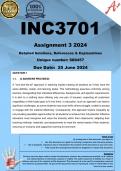INC3701
Assignment 3 2024
Detailed Solutions, References & Explanations
Unique number: 688457
Due Date: 25 June 2024
QUESTION 1
1.1. (2 ANSWERS PROVIDED)
A "one-size-fits-all" approach in teaching implies treating all students as if they have the
same abilities, needs, and learning styles. This methodology assumes uniformity among
learners, disregarding their individual differences, backgrounds, and specific requirements.
It is akin to a clothing store offering only one pair of trousers, expecting all customers
(regardless of their body type) to fit into them. In education, such an approach can lead to
significant challenges, as some students may excel while others struggle, unable to access
or engage with the material effectively. Consequently, this approach fosters inequality by
not providing equitable opportunities for all students to achieve their full potential. Effective
educators must recognize and value the diversity within their classrooms, adapting their
teaching methods, materials, and assessments to meet the varied needs of their students,
ensuring an inclusive and supportive learning environment.
Terms of use
By making use of this document you agree to:
• Use this document as a guide for learning, comparison and reference purpose,
• Not to duplicate, reproduce and/or misrepresent the contents of this document as your own work,
• Fully accept the consequences should you plagiarise or misuse this document.
Disclaimer
Extreme care has been used to create this document, however the contents are provided “as is” without
any representations or warranties, express or implied. The author assumes no liability as a result of
reliance and use of the contents of this document. This document is to be used for comparison, research
and reference purposes ONLY. No part of this document may be reproduced, resold or transmitted in any
form or by any means.
, +27 67 171 1739
QUESTION 1
1.1. (2 ANSWERS PROVIDED)
A "one-size-fits-all" approach in teaching implies treating all students as if they have
the same abilities, needs, and learning styles. This methodology assumes uniformity
among learners, disregarding their individual differences, backgrounds, and specific
requirements. It is akin to a clothing store offering only one pair of trousers, expecting
all customers (regardless of their body type) to fit into them. In education, such an
approach can lead to significant challenges, as some students may excel while others
struggle, unable to access or engage with the material effectively. Consequently, this
approach fosters inequality by not providing equitable opportunities for all students to
achieve their full potential. Effective educators must recognize and value the diversity
within their classrooms, adapting their teaching methods, materials, and assessments
to meet the varied needs of their students, ensuring an inclusive and supportive
learning environment.
OR
A "one-size-fits-all" approach in teaching assumes that all students can learn in the
same way, at the same pace, and through the same teaching methods. This approach
tends to use standardized lesson plans, instructional methods, and assessments
without considering the diverse needs, backgrounds, and abilities of individual
learners. For instance, it might involve teaching a subject using only one method, such
as lectures, and assessing all students through the same type of test, regardless of
their learning styles or difficulties.
This method is problematic because students are not homogenous—they have varied
learning preferences, cultural backgrounds, languages, and abilities. A one-size-fits-
all approach can marginalize students who don't conform to the "standard" and can
prevent them from reaching their full potential. Effective teaching requires
differentiation, which involves adapting instruction to meet the diverse needs of
students, thereby ensuring equitable access to learning opportunities for all. This way,
all students can be engaged and supported according to their individual learning
needs.
Disclaimer
Extreme care has been used to create this document, however the contents are provided “as is” without
any representations or warranties, express or implied. The author assumes no liability as a result of
reliance and use of the contents of this document. This document is to be used for comparison, research
and reference purposes ONLY. No part of this document may be reproduced, resold or transmitted in any
form or by any means.





